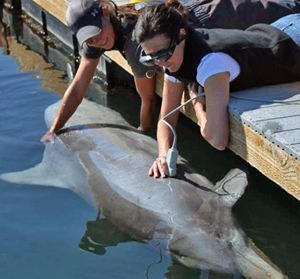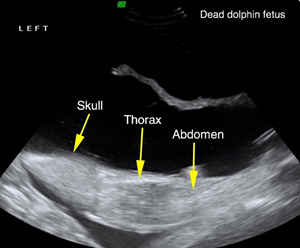
Megan Tormey (left) and Cynthia Smith (right) of NMMF conduct a voluntary ultrasound examination of a Navy dolphin in San Diego Bay, California, utilizing a heads-up video display (virtual reality glasses) to view the ultrasound image in real time. (Photo courtesy of U.S. Navy)
Concern about how the Deepwater Horizon oil spill may continue to negatively affect wild bottlenose dolphins living in the spill’s footprint remains high. Researchers supporting the Natural Resource Damage Assessment (NRDA) studied live and stranded dolphins in the heavily affected area of Louisiana’s Barataria Bay and reported that exposed dolphins exhibited increased lung disease, adrenal gland abnormalities, late-term pregnancy losses, and an 80% reproductive failure rate – four times greater than dolphins from unaffected areas. So how are the dolphins doing now?
The Gulf of Mexico Research Initiative recently awarded Dr. Cynthia Smith a grant to further investigate the dolphins’ reproductive impairment after the oil spill. Many stranded perinatal dolphins (perinates) in this region showed evidence of fetal distress and subsequent death in the womb and exhibited high reproductive failure rate. This project seeks to better understand how oil spill exposure impaired the reproductive health of this population through more precise physiologic measures and to assess how long these negative reproductive effects could last.

NMMF’s Cynthia Smith (left) and Randall Dear performing ultrasound on a bottlenose dolphin during a previous NOAA-led health assessment. (Photo by Todd Speakman, NOAA; NMFS permit #18786)
The project’s veterinary and research teams will care for dolphins from the Navy’s Marine Mammal Program that have documented health histories and receive ongoing assessments to develop advanced diagnostic techniques that will be applied to Barataria Bay dolphin capture-release field studies. The techniques will help identify fetal, placental, and maternal abnormalities potentially contributing to increased reproductive failure. The teams will use blood-based hormone testing for fetal and placental health evaluations and to assess potential mechanisms driving reproductive failure.

Dolphin Y01 pushing a dead calf in Barataria Bay, Louisiana, in March 2013.
(Photo by Louisiana Department of Wildlife and Fisheries)
Examinations of live, pregnant Barataria Bay dolphins and comparisons with documented Navy dolphin pregnancies will help establish current maternal health, pregnancy status, and fetal and placental health scores. The researchers will track the reproductive health of Barataria Bay dolphin mothers using boat-based monitoring. Parallel studies will evaluate dead adult and perinatal dolphins stranded during the study period for lesions and cause of death. The team will assess tissue samples from dead perinates for evidence of fetal distress, inflammation, and signs that a breath was taken outside of the womb. Then they will compare results with tissue analyses from historical Navy perinate losses to identify potential risk factors and predictors of late-term perinatal losses.

Ultrasound image of a dead dolphin fetus acquired by NMMF’s Cynthia Smith and Veronica Cendejas in Barataria Bay 2011 (NMFS permit #932-1905/MA-009526). (Provided by Cynthia Smith)
The project’s researchers believe that the development of advanced technologies and establishment of baseline reproductive health data will enhance the medical evaluation of Barataria Bay dolphins and advance diagnostic capacities for small cetaceans.
Smith elaborated, “This research will lend insight into the progression of disease states that are likely contributing to loss and inform our understanding of the potential timeline for recovery with regard to successful reproduction. Once we define why these animals are losing their babies, we can help determine the best way to develop strategies for their protection and recovery.”

Ultrasound image of a live dophin fetus acquired by NMMF’s Cynthia Smith and Veronica Cendejas in Barataria Bay 2011 (NMFS permit #932-1905/MA-009526). (Provided by Cynthia Smith)
This project’s researchers are Cynthia Smith, Lori Schwacke, and Stephanie Venn-Watson of the National Marine Mammal Foundation (NMMF) and Teri Rowles of the National Oceanic and Atmospheric Administration (NOAA). Their project is Investigation of Mechanisms for Reproductive Failure in the Aftermath of the Deepwater Horizon Oil Spill to Understand Population Recovery Scenarios for Cetaceans.
************
The Gulf of Mexico Research Initiative (GoMRI) is a 10-year independent research program established to study the effect, and the potential associated impact, of hydrocarbon releases on the environment and public health, as well as to develop improved spill mitigation, oil detection, characterization and remediation technologies. An independent and academic 20-member Research Board makes the funding and research direction decisions to ensure the intellectual quality, effectiveness and academic independence of the GoMRI research. All research data, findings and publications will be made publicly available. The program was established through a $500 million financial commitment from BP. For more information, visit http://gulfresearchinitiative.org/.
